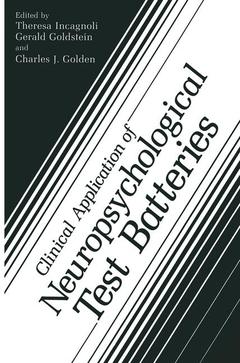Description
Clinical Application of Neuropsychological Test Batteries, Softcover reprint of the original 1st ed. 1986
Coordinators: Golden Charles J., Goldstein Gerald, Incagnoli Theresa M.
Language: English
Subjects for Clinical Application of Neuropsychological Test Batteries:
Publication date: 03-2012
424 p. · 15.2x22.9 cm · Paperback
424 p. · 15.2x22.9 cm · Paperback
Description
/li>Contents
/li>
Clinical neuropsychology has become a field of major prominence dur ing the past several years, as well as a field of great complexity. As a result of the extensive amount of activity that neuropsychology has experienced recently, two major developments have emerged. First, several approaches have evolved regarding comprehensive neuro psychological assessment. There are presently several standard test bat teries in common use, as well as an approach to assessment that does not make use of standard batteries, but rather fits the evaluation accom plished to the particular diagnostic problems presented by the indi vidual patient. Second, a great deal of specialization has emerged, with assessment procedures developed for evaluation of specific types of neuropsychological deficit. The purpose of this volume is to review these developments, particularly with reference to their implications for application in clinical settings. The history of this book's development is of particular interest. Some years ago, the Veterans Administration became concerned with developing an optimal method of neuropsychological assessment for its many health-care related facilities. Initially, the problem was con ceptualized in terms of whether the VA should encourage wider use of the long-established Halstead-Reitan Neuropsychological Test Battery (HRB) or promote more extensive use of the recently developed Luria Nebraska Neuropsychological Test Battery (LNNB). A conference was funded to bring together authorities in clinical neuropsychology to dis cuss this matter and present a series of papers to invited psychologists from various VA facilities.
1 Current Directions and Future Trends in Clinical Neuropsychology.- The Evolving Role of the Clinical Neuropsychologist.- Framework Within Which to Conduct Neuropsychological Evaluation.- Approaches to Evaluation.- Current Issues and Future Directions in Clinical Neuropsychology.- References.- 2 Clinical Interviewing of the Patient and History in Neuropsychological Assessment.- Purposes of the Interview and History in Neuropsychological Assessment.- The Role of the Interview and History in Treatment Planning.- Assessment Methods.- General Summary and Conclusions.- References.- 3 The Role of Standard Cognitive and Personality Tests in Neuropsychological Assessment.- Neuropsychology and the Role of Assessment.- Neurodiagnosis and the Standard Battery.- Assessment Versus Screening.- Future Directions.- Summary and Conclusions.- References.- 4 The Flexible Battery in Neuropsychological Assessment.- Nonfocal Cognitive Deficits and their Evaluation.- Focal Cognitive Deficits and their Evaluation.- References.- 5 Neuropsychological Batteries.- Characteristics of Test Batteries.- Types of Test Batteries.- Theoretical Bias in Battery Development.- A Decision Approach to Systematic Assessment.- The Meaning of Neuropsychological Test Results.- Dimensions of Neuropsychological Assessment.- Assessment of Children and Adults: Special Considerations.- Normative and Criterion Assessment.- Summary.- References.- 6 Overview of the Halstead-Reitan Battery.- Development of the Halstead-Reitan Battery.- Clinical Application of the Halstead-Reitan Battery.- Examples of Neuropsychological Reports.- Future Developments of the Halstead-Reitan Battery.- References.- 7 The Luria-Nebraska Neuropsychological Battery.- The Luria-Nebraska Scales.- Research on the Luria-Nebraska.- Interpretation of the Luria-Nebraska.- References.- 8 An Overview of Similarities and Differences between the Halstead-Reitan and Luria-Nebraska Neuropsychological Batteries.- Historical Considerations.- Similarities and Differences.- Questions and Answers.- Concluding Remarks.- References.- 9 Comparison of Halstead-Reitan and Luria-Nebraska Neuropsychological Batteries: Research Findings.- Studies Using Raters.- Statistical Relationships.- The HRB, LNNB, and Psychometric Intelligence.- The LNNB and the Assessment of Memory.- Concluding Comments.- References.- 10 A Comparison of the Halstead-Reitan, Luria-Nebraska, and Flexible Batteries Through Case Presentations.- A Case of Huntington’s Disease.- A Case of Schizophrenia.- A Case of Mnestic Dysfunction in Thalamic Infarction.- Summary.- References.- 11 Assessment of Aphasia.- The Development of Aphasia Testing.- Principles of Aphasia Testing.- Comprehensive Aphasia Examinations.- Tests of Communicative Function.- Short Screening Tests in Aphasia.- Aphasia Examinations for Polyglots, and in other Languages.- Modality Specific Tests of Aphasia.- Conclusion.- References.- 12 The Clinical Aspects of Memory Disorders: Contributions from Experimental Studies of Amnesia and Dementia.- Comparisons of the Memory Disorders of Patients with Alcoholic Korsakoff’s Syndrome and Patients with Huntington’s Disease.- Conclusions.- References.- 13 Visual-Spatial Disabilities.- Constructional Apraxia.- Recognition and Discrimination of Faces.- Dressing Apraxia.- Optic Ataxia.- Topographical Disorientation.- Neglect.- Perception of Direction.- Conclusion.- References.
© 2024 LAVOISIER S.A.S.
These books may interest you

Neuropsychological Assessment 218.01 €



